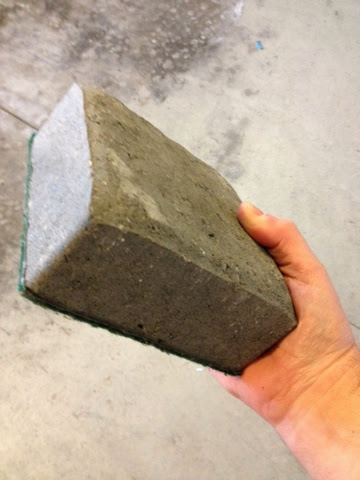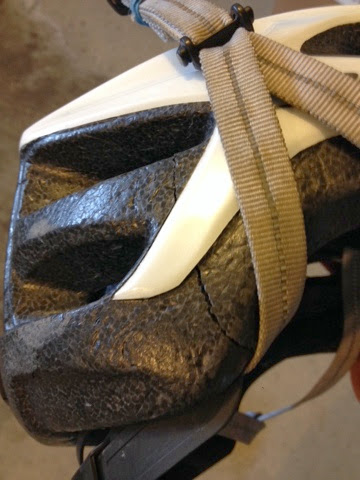DISCLAIMER: Nothing you are about to see should be taken as a legitimate safety test, an endorsement or anti-endorsement of any particular helmet, or even an endorsement or anti-endorsement of helmets in general. Do not try this at home with a real head. And no, I do not want to argue the pros and cons of helmets with you.
First, the substitute head -- a cement block of unknown weight. Maybe 10 pounds? A perfect stand-in for yours truly, as I'm something of a blockhead:
The test consisted of placing said block into the aged helmet, holding the helmet/block combo at approximately head height (six feet or so) helmet-side-down, and dropping the whole mess repeatedly onto a concrete floor. Again, no science is implied here, just an immature desire to bust things.
It took about three drops before real damage started to appear in the helmet's guts. Note the major crack in the center of the photo, and another forming up and to the right of that one:
After a couple more drops, a crack formed in the outer shell:
A couple more drops, and things are really starting to look ugly on the inside. The retention loop that goes around the back of the head is detached at this point. This is why I don't use my own head for testing:
Finally, after maybe ten drops total, the back end started to separate from the rest of the helmet, which was its eventual failure mode -- the whole rear/lower section unhinged from the front like a snake swallowing an egg.
Some observations:
- The impact (though it made no attempt to simulate anything remotely real) was quite violent and noisy. Sobering stuff.
- Given the violence of the bang, I was shocked at how "normal" the helmet looked after the first drop. If I didn't know it had been damaged, I never would have noticed anything amiss.
- Thanks to the first two bullet points, I now understand (viscerally) that the manufacturer's recommendation to replace a helmet after one impact is not just "we want to sell you another helmet" hooey. These things are designed to give their lives for yours.
- With all that being said, I was impressed at how much integrity the helmet maintained after repeated hits. We're talking a lid that's many years old and pretty crusty, yet it kept its shape through more impacts than I would have expected.
- I probably would have kept going, but there was a point where the Beavis and Butthead element of it wore off and I started thinking about the times I've actually put helmet to pavement (or tree, or rock) with my head inside. That's when it got creepy and I had to stop.
In fact, I just re-creeped myself out enough that I'm going to repeat my disclaimer: Nothing you just saw should be taken as a legitimate safety test, an endorsement or anti-endorsement of any particular helmet, or even an endorsement or anti-endorsement of helmets in general. Do not try this at home with a real head. And no, I do not want to argue the pros and cons of helmets with you.
Let's be careful out there.








